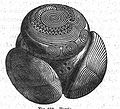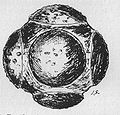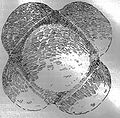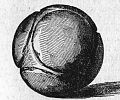- Carved Stone Balls
-
Die Carved Stone Balls (gravierte Steinkugeln) sind als etwas mehr als 420 Exemplare bekannt. Sie entstanden im späten Neolithikum und in der Bronzezeit (3500–1500 v. Chr.) Die meisten wurden im nordlichen Schottland im Aberdeenshire zwischen Moray Firth und Tay-Fluss bei den Grampian Mountains gefunden. Es gab auch einige Funde in Irland, England und in Skara Brae auf Orkney. Über den Zweck der Steinkugeln gibt es zahlreiche Vermutungen. Meist wird angenommen, dass es sich um Statussymbole handelte.[1]
Für die Objekte wurden unterschiedliche Gesteine verwendet, wie Hartgesteine: (Granit, Gabbro, Gneis, Diabas, Diorit und Quarzit) und Weichgesteine: (Sandstein und Serpentinit). Die Verzierung hängt von den verwendeten Steinarten ab, denn die Hartgesteine sind wesentlich schwieriger zu formen und zu bearbeiten als die Weichgesteine. Schnitzen kann man allerdings keines dieser Gesteine.
Inhaltsverzeichnis
Gestaltung und Herstellung
Die zumeist kugelartigen Objekte sind sorgfältig und aufwändig gestaltet und variieren sehr stark. Die meisten haben einen Durchmesser von 70 mm. Etwas mehr als ein Dutzend liegen zwischen 90-114 mm. Viele sind fast rund und nur wenige oval. Die meisten haben sechs Noppen, die am besten gestalteten Kugeln haben vier Noppen und die anderen weisen eine unterschiedliche Anzahl auf. Die Größe der häufig mit eingravierten Mustern verzierten Noppen variiert. Die Muster bestehen aus linearen, spiralförmigen oder konzentrischen Ritzungen. Es gibt auch Kugeln ohne Verzierungen.
-
Gefunden in Towie Aberdeenshire
-
Gefunden in Kilmaurs, Schottland
Der Forscher Andrew T. Young hat in einer experimentellen, wissenschaftlichen Untersuchung festgestellt, dass die schottischen Steinkugeln mit prähistorischen Werkzeugen, ohne Verwendung von Metallen, geformt werden konnten.[2]
Erste Untersuchungen und Fundorte
F. R. Coles, ein Beschäftigter des National Museum of Antiquities of Scotland, untersuchte in den Jahren von 1897 bis 1911 etwa 180 Steinkugeln und veröffentlichte das Ergebnis im Jahre 1911 und ein weiterer Beschäftigter des Museums, Bulmer, fertigte Karten davon an.
Carved Stone Balls wurden in Aberdeenshire, Dunadd, Hawick, Wigtownshire auf Iona, Skye, Lewis and Harris, Uist, Arran und auf Orkney gefunden. Außerhalb Schottlands in Irland bei Ballymena sowie in England bei Durham, Cumbria, Lowick und Bridlington. Die mit sieben Noppen gestalteten Kugeln aus Diorit, die in Hillhead, bei St. Ola, auf Orkney gefunden wurden, stammen von Hillswick auf den Shetlands.[3] Auf Orkney wurden in der steinzeitlichen Siedlung Skara Brae, die von der UNESCO zum Weltkulturerbe erklärt wurde, fünf Carved Stone Objects gefunden.[4]
Weblinks
- Carved stone balls von Dorothy N. Marshall (englisch)
- Abbildungen von Carved Stone Balls auf der Webseite der University of Aberdeen (englisch)
- F.S.A. Scot: The carved stone balls of scotland: A neu theory as to their use (englisch)
- Skara Brae
Einzelnachweise
- ↑ Information der Ashmolean Museum, abgerufen am 19. Mai 2010
- ↑ Universität of Exter, The ground stone tools of Britain and Ireland: An experimental approach von Andrew T. Young, abgerufen am 19. Mai 2010
- ↑ Carved stone balls von Dorothy N. Marshall S. 34, abgerufen am 19. Mai 2010
- ↑ Abbildungen von Carved Stone Balls auf Skara Brae auf der Webseite des National Museums Scotland, abgerufen am 19. Mai 2010
Kategorien:- Archäologischer Fund (Vereinigtes Königreich)
- Bronzezeit
-
Wikimedia Foundation.





